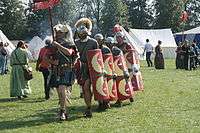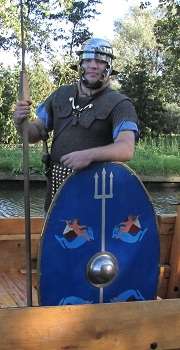Pax Romana (reenactment)
Pax Romana is a Classical reenactment society based in the Netherlands, with the main goal to show Romans in the Netherlands as they would have lived in the last quarter of the first century AD.
| Pax Romana | |
|---|---|
| Location | Netherlands |
| Period | Ancient Rome |
| Earliest year portrayed | 69 AD |
| Latest year portrayed | 79 AD |
| Website | www |


Origin
The group was set up in 2007 by a group of Ancient Rome enthusiasts, including archaeologists and a Latinist. The group is member of the Landelijk Platform voor Levende Geschiedenis.
Nature and purpose
Pax Romana works as a living history and re-enactment group. The goal is primarily education and is put into practice through the medium of displays (military encampments and civilian cooking and crafts), school visits and film and TV projects in the form of advice, equipment and cast.
As their members come from all over the Netherlands, the society has no primary base. There are currently (2015) around twenty members, of which about fifteen in Roman military life. The military members are encouraged to create a fictional character to portray at events. In order to provide the greatest degree of authenticity the group uses accurate reproductions of equipment, and strives to copy authentic haircuts, mannerisms and so on through research and under advice from archaeologists and historians. While the men mainly portray the military life, women and children form the Batavian and Roman civilians.
Units portrayed
Pax Romana has the capability to reconstruct multiple branches of the Roman military and Batavian civilians. The Cohors XV is the main military unit.
Cohors XV Voluntariorum Civium Romanorum
The 15th cohort of Roman volunteers is one of the most well-known Roman units of the Netherlands in Roman times. This unit consisted of old legionnaires and veterans and was called Voluntariorum (Volunteers). Stamps and inscriptions of the unit have been found at the castella Leiden-Roomburg (Matilo) en Woerden (Laurium). As far as known today the 15th cohort was in both fortresses between 70 and 240-250 AD. Stamps were also found in Alphen aan den Rijn (Albaniana), Utrecht, Vechten (Fectio) and Cologne (Colonia Agrippina). These were probably build by the material the soldiers of the 15th cohort fabricated.
Civilians
The civilians are formed by Batavians and Romans. The Batavi were an ancient Germanic tribe, originally part of the Chatti,[1] that lived around the Rhine delta, in the area that is currently the Netherlands, from the second half of the first century BC to the third century AD. The Roman civilians distinguish themselves by the use of more 'Romanised' clothing, jewelry and haircuts.
Projects
Pax Romana has multiple projects portraying different types of Roman military units.
Classis Augusta Germanica
The Classis Germanica was established in 12 BC by Drusus at Castra Vetera.[2] It controlled the Rhine river, and was mainly a fluvial fleet, although it also operated in the North Sea. It is noteworthy that the Romans' initial lack of experience with the tides of the ocean left Drusus' fleet stranded on the Zuyder Zee.[3] After ca. 30 AD, the fleet moved its main base to the castrum of Alteburg, some 4 km south of Colonia Agrippinensis (modern Cologne).[4] Later granted the honorifics Augusta Pia Fidelis Domitiana following the suppression of the Revolt of Saturninus.[5] The classis Germanica rendered outstanding services in multitudinous landing operations. In 46, a naval expedition made a push deep into the Black Sea region and even travelled on the Tanais. In 47 a revolt by the Chauci, who took to piratical activities along the Gallic coast, was subdued by Gnaeus Domitius Corbulo.[6] By 57 an expeditionary corps reached Chersonesos (see Charax, Crimea).
Gladiators
Gladiatorial combats are well known as public entertainment in ancient Roman times. Pax Romana currently has a retiarius, secutor, Thraex, hoplomachus and murmillo.
Cohortes Urbanae
The Cohortes Urbanae served as a police force in Rome and several other major Roman cities.
Notes
- Tacitus, Germania, 29.
- Cleere (1977), p. 16
- Webster & Elton (1998), p. 160
- Köln-Alteburg at livius.org
- Webster & Elton (1998), p. 162
- Webster & Elton (1998), p. 161